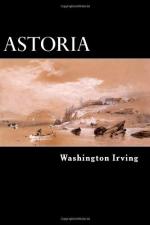Though Mr. Thompson could be considered as little better than a spy in the camp, he was received with great cordiality by Mr. M’Dougal, who had a lurking feeling of companionship and good-will for all of the Northwest Company. He invited him to head-quarters, where he and his people were hospitably entertained. Nay, further, being somewhat in extremity, he was furnished by Mr. M’Dougal with goods and provisions for his journey back across the mountains, much against the wishes Of Mr. David Stuart, who did not think the object of his visit entitled him to any favor.
On the 23rd of July, Mr. Stuart set out upon his expedition to the interior. His party consisted of four of the clerks, Messrs. Pillet, Ross, M’Lennon, and Montigny, two Canadian voyageurs, and two natives of the Sandwich Islands. They had three canoes well laden with provisions, and with goods and necessities for a trading establishment.
Mr. Thompson and his party set out in company with them, it being his intention to proceed direct to Montreal. The partners at Astoria forwarded by him a short letter to Mr. Astor, informing him of their safe arrival at the mouth of the Columbia, and that they had not yet heard of Mr. Hunt. The little squadron of canoes set sail with a favorable breeze, and soon passed Tongue Point, a long, high, and rocky promontory, covered with trees, and stretching far into the river. Opposite to this, on the northern shore, is a deep bay, where the Columbia anchored at the time of the discovery, and which is still called Gray’s Bay, from the name of her commander.
From hence, the general course of the river for about seventy miles was nearly southeast; varying in breadth according to its bays and indentations, and navigable for vessels of three hundred tons. The shores were in some places high and rocky, with low marshy islands at their feet, subject to inundation, and covered with willows, poplars, and other trees that love an alluvial soil. Sometimes the mountains receded, and gave place to beautiful plains and noble forests. While the river margin was richly fringed with trees of deciduous foliage, the rough uplands were crowned by majestic pines, and firs of gigantic size, some towering to the height of between two and three hundred feet, with proportionate circumference. Out of these the Indians wrought their great canoes and pirogues.
At one part of the river, they passed, on the northern side, an isolated rock, about one hundred and fifty feet high, rising from a low marshy soil, and totally disconnected with the adjacent mountains. This was held in great reverence by the neighboring Indians, being one of their principal places of sepulture. The same provident care for the deceased that prevails among the hunting tribes of the prairies is observable among the piscatory tribes of the rivers and sea-coast. Among the former, the favorite horse of the hunter is buried with him in the same funereal mound, and




